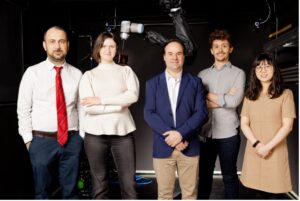The project at a glance
-
Start date:01 Jan 2022
-
Duration in months:24
-
Funding:FNR
-
Principal Investigator(s):Carol Martinez
About
Space debris is an environmental catastrophe whose effects are becoming increasingly dangerous. Any fragment may hit a satellite, creating other debris and potentially causing a cascading chain reaction. For the fast-growing market of small satellites, offering services such as high-speed internet connectivity in remote areas, extreme weather forecast, maritime and aviation tracking data, but also data for scientific research, debris is a huge problem. Eventually, it will not be possible to place spacecraft into orbit without significant risk of damage. While many ‘capture and removal’ systems have been proposed over the last decade, so far none of them have been effectively deployed. A partnership agreement between SnT’s Space Robotics (SpaceR) research group, and Spacety, a global newspace company specialised in small satellites and satellite-based services, proposes to change that by studying small satellite solutions for active space debris removal. Currently, the team has received two FNR grants related to this partnership. The FNR-IF Ph.D. grant focuses on the “Design of a Capturing, Absorbing and SEcuring system for active Debris removal” (CASED). On the other hand, with the FNR-Bridges project “High-fidELity tEsting enviroNment for Active Space Debris Removal” (HELEN), the joint team is leveraging the potential of the 2D micro-gravity facility (Zero-G lab) of the University of Luxembourg to validate a CubeSat-based concept for space debris removal. The team aims to develop advanced computational methods to recreate high-fidelity, photorealistic in–orbit scenarios for testing purposes. To do so, the project will be integrating software–in–the-loop (SIL) and hardware–in–the–loop (HIL) approaches – basically feeding laboratory data to the simulation software and vice-versa. Ultimately, the team aims to create a framework for testing debris removal systems in the Zero-G lab. The use of the lab’s advanced capabilities in the framework of this project will allow the CubeSat-based ASDR system to reach a technology readiness level of up to six, pushing the technology to the deployment stage in a shorter period of time.
Organisation and Partners
- Interdisciplinary Centre for Security, Reliability and Trust (SnT)
- Space Robotics Research Group (SpaceR)
- Spacety
Project team
-
Carol Martinez
-
Miguel Olivares-Mendez
-
Baris Yalcin
-
Maxime Hubert Delisle
-
Xiao Li
-
James Zheng
Spacety
-
Gonzalo Rodriguez
Spacety
Keywords
- Active debris removal
- Space debris
- Small satellites
- Robotics
- Hardware-in-the-loop
- Software-in-the-loop
- CubeSat
- ASDR
